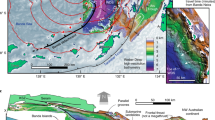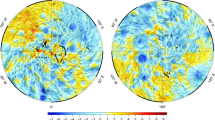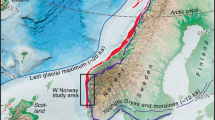Abstract
The surface of Phobos, the inner satellite of Mars, is marked by a series of linear depressions or grooves. These have been interpreted as surface manifestations of internal fractures1,2. The origin of these fractures has been ascribed to tidal stresses induced by the decay of Phobos' orbit3, or to a nearly catastrophic cratering event2.I suggest here that the age and distribution of the grooves may be explained by a hybrid origin due to varying tidal stresses induced after a large impact altered the satellite's rotation rate.
This is a preview of subscription content, access via your institution
Access options
Subscribe to this journal
Receive 51 print issues and online access
$199.00 per year
only $3.90 per issue
Buy this article
- Purchase on Springer Link
- Instant access to full article PDF
Prices may be subject to local taxes which are calculated during checkout
Similar content being viewed by others
References
Thomas, P. thesis, Cornell Univ. (1978).
Thomas, P., Veverka, J. & Duxbury, T. Nature 273, 282–284 (1978).
Soter, S. & Harris, A. Nature 268, 421–422 (1977).
Soter, S. CRSR Rep. 462 (Cornell University, 1972).
Burns, J. Rev. Geophys. Space Phys. 10, 463–483 (1972).
Goldreich, P. Astrophys. J. 71, 1–7 (1966).
Aggarwal, H. & Oberbeck, V. Astrophys. J. 191, 577–588 (1974).
Soter, S. & Harris, A. Icarus 30, 192–199 (1977).
Jeffreys, H. The Earth 5th edn 471–484 (Cambridge University Press, 1970).
Author information
Authors and Affiliations
Rights and permissions
About this article
Cite this article
Weidenschilling, S. A possible origin for the grooves of Phobos. Nature 282, 697–698 (1979). https://doi.org/10.1038/282697a0
Received:
Accepted:
Issue Date:
DOI: https://doi.org/10.1038/282697a0
This article is cited by
-
The origin and specific features of the martian satellites in the context of the euruption concept
Earth, Moon, and Planets (1988)
Comments
By submitting a comment you agree to abide by our Terms and Community Guidelines. If you find something abusive or that does not comply with our terms or guidelines please flag it as inappropriate.



